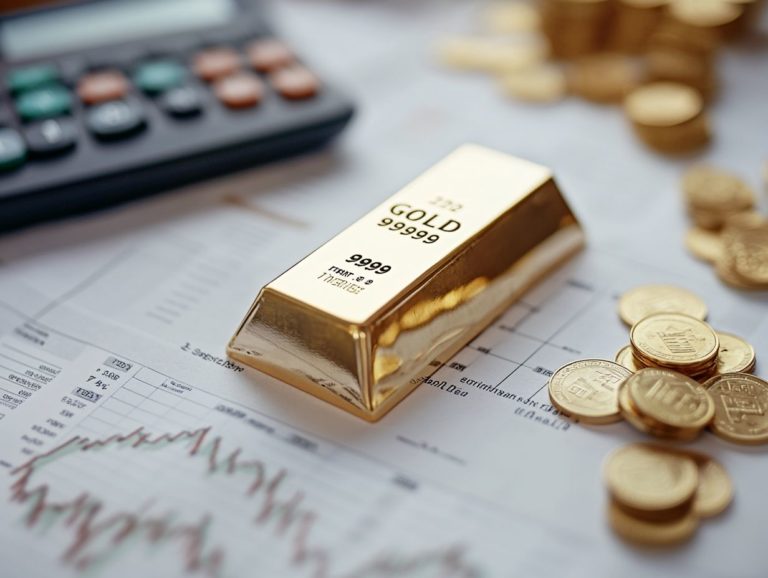Gold as a Safe Haven: Myth or Reality?
In times of economic uncertainty, you often seek refuge in safe haven assets investments expected to retain or even increase in value during market turmoil.
Gold has long maintained a prominent position in this realm, celebrated for its historical stability and enduring allure.
This article invites you to explore the essence of safe haven assets, delve into gold’s performance over time, and examine the factors influencing its esteemed status. This article also highlights other investment options you might find interesting.
Dive in now to discover if gold is the ultimate safe haven or if there are other contenders worth your investment!
Contents
Key Takeaways:

- Gold has long been considered a safe haven asset due to its historical performance and ability to retain value during economic and geopolitical uncertainties.
- Factors such as inflation, interest rates, and political instability can affect gold’s status as a safe haven, making it crucial to continuously evaluate its role in a portfolio.
- While gold remains a popular safe haven option, there are other alternatives such as government bonds and currencies that may also provide protection during market volatility.
Understanding the Concept of Safe Haven Assets
Safe haven assets are valuable investments you choose during economic turbulence. They provide security and stability when markets are unpredictable. These investment options are crafted to preserve value over time, often acting as a shield against rising prices and the volatility that comes with traditional investments like stocks and bonds.
When economic crises strike, savvy investors instinctively gravitate toward these assets to protect their purchasing power and ensure financial stability. Grasping the characteristics and historical performance of these safe havens is crucial for achieving effective investment diversification.
What are Safe Haven Assets?
Safe haven assets are your go-to investments when the market gets rocky and economic crises loom large. These assets provide a sanctuary for those looking for stability amidst the chaos. Think of gold and other precious metals silver and platinum are also in the mix as some of the most recognized examples.
Their intrinsic value, rooted in historical significance and tangible properties, serves as a safeguard against risks like currency devaluation and rampant inflation. When economic uncertainty strikes, many investors often gravitate toward government bonds or real estate, as these options tend to hold strong against declining stock prices.
Understanding these assets empowers you to make smarter financial choices even when the going gets tough.
The Role of Gold as a Safe Haven Asset
You understand that gold has long been celebrated as a premier safe haven asset. Its reputation stems from its remarkable ability to serve as protection against rising prices and preserve wealth during times of economic uncertainty, especially in recessionary periods and amidst geopolitical unrest.
Historical Performance and Trends

The historical performance of gold clearly demonstrates its resilience as a safe haven asset, with price movements intricately tied to investor behavior in response to economic policy uncertainty and global events.
Throughout the decades, particularly during times of hyperinflation, recession, and geopolitical turmoil, gold has consistently emerged as a reliable buffer against financial instability. For instance, during the 2008 financial crisis, its significant price surge showed that investors flock to this precious metal when traditional currencies begin to falter. In a similar vein, the COVID-19 pandemic triggered market volatility that led many to reassess their portfolios, resulting in unprecedented interest in gold.
By grasping these dynamics, you can gain deeper insights into how this asset continues to capture attention and maintain its allure amidst ever-changing economic landscapes.
Factors Affecting Gold’s Status as a Safe Haven
The status of gold as a safe haven asset is shaped by a range of economic and geopolitical factors that you ll want to pay attention to. This includes inflation rates, market turbulence, and the measures taken by central banks like the Federal Reserve.
Staying attuned to these influences can provide valuable insights into gold’s performance and its role in your investment strategy.
Economic and Geopolitical Factors
Geopolitical unrest and economic crises wield considerable influence over gold’s reputation as both an inflation hedge and a safe haven asset. These factors shape financial markets and guide your investment choices.
The recent surge in gold prices can be traced back to rising tensions in areas like Eastern Europe and the Middle East. Conflicts in these regions have driven many investors to seek refuge in tangible assets.
Currency fluctuations also influence gold’s status. The monetary policies of central banks, particularly concerning interest rates, have reinforced gold’s status as a dependable store of value in uncertain times.
Events such as trade wars, sanctions, and even global pandemics serve as poignant reminders of gold’s reflective nature. It often mirrors investor sentiment, acting as a barometer for market behavior and trends.
In this way, gold demonstrates its dual role in wealth preservation and risk mitigation, making it a strategic consideration in your investment portfolio.
Other Safe Haven Alternatives to Gold
While gold typically serves as the primary safe haven asset, you may want to explore several alternatives that savvy investors consider during turbulent market conditions. Don t miss out on these options!
These alternatives include other precious metals and select financial products that can provide stability and potential returns when the market becomes unpredictable.
Comparison with Other Assets

When you compare gold with other safe haven assets like bonds and cash equivalents, you’ll uncover distinct advantages and disadvantages related to risk, return on investment, and financial stability.
Bonds might promise a steady income through interest payments, but their performance can take a hit during inflationary periods, ultimately eroding your purchasing power. On the other hand, gold has managed to maintain its historical value over centuries, often acting as a hedge against inflation and currency fluctuations.
When market uncertainty looms, investors tend to gravitate toward gold, perceiving it as a reliable store of value. This typically boosts demand and drives up prices.
This behavior starkly contrasts with bonds, which may not offer the same level of protection during crises. This reinforces the importance of diversifying your asset classes to create a well-balanced investment portfolio.
Evaluating the Evidence
Evaluating the evidence behind gold’s status as a safe haven asset requires you to analyze its historical performance and grasp the associated extra return for taking on risk during times of market uncertainty.
This analysis shows that gold has consistently outperformed other asset classes when economic turmoil strikes. This demonstrates its remarkable ability to maintain value while equities stumble.
For you as an investor, this highlights the importance of allocating a portion of your portfolio to gold, especially when market volatility intensifies.
Empirical studies reveal a significant inverse correlation between gold prices and stock market performance. This suggests that incorporating gold can effectively mitigate overall portfolio risk.
As global economic dynamics continue to change, the insights gleaned from gold’s historical resilience can profoundly shape your future investment strategies. This guidance can lead you toward a more diversified and balanced approach.
Frequently Asked Questions
1. Is Gold truly a safe haven asset?
Yes, gold is considered to be a safe haven asset due to its long history of maintaining its value during times of economic and geopolitical uncertainty. Investors can determine if it s right for their portfolio by assessing their risk tolerance and market conditions.
Looking for more insights? Consider subscribing for updates or consult a financial advisor for personalized advice!
2. How does Gold act as a safe haven?

During market instability, investors often seek safe assets. Gold is one of these assets because it holds its value well, leading to increased demand and higher prices.
3. Are there any drawbacks to Gold as a safe haven?
Gold’s value can fluctuate due to several factors. Interest rates, inflation, and supply and demand can all impact its price.
4. Has Gold always been a safe haven asset?
Gold’s role as a safe haven has changed over time. It was once used as currency but has evolved into a preferred option for stability during uncertain times.
5. Can Gold be a good long-term investment?
Gold is often viewed as a reliable long-term investment. Still, it’s wise to diversify your portfolio and not depend solely on Gold.
6. Is Gold the only safe haven asset?
Other safe haven assets include government bonds, cash, and certain currencies. Investors should explore all options before making decisions.















